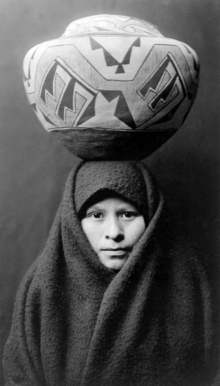Zuni

Zuni folket er et af de indianske pueblofolk i USA, som især bor i Zuni Pueblo og det omkringliggende område i New Mexico. Zuni sproget er et isoleret sprog, som ikke påviseligt er beslægtet med andre indianske sprog. Zunierne har formentlig boet som landbrugsfolk i samme område i mindst 3,000 til 4,000 år, og har muligvis været relateret til den arkæologiske Mogollón kultur.[1] Zunierne er kendt for deres håndværk: flettede kurve, sølvsmedearbejde, vævede tekstiler; og også for deres religiøse traditioner som søger at holde hemmelige for udefrakommende. I 2000, var der 10,228 medlemmer af zunistammen.[2]



Noter
- ^ Doelle, W. H. (2009). Zuni origins: toward a new synthesis of Southwestern archaeology. D. A. Gregory, & D. R. Wilcox (Eds.). University of Arizona Press.
- ^ "Zuni Pueblo." Arkiveret 29. april 2012 hos Wayback Machine Arizona Native Net. Retrieved 21 April 2012.
Medier brugt på denne side
"Zuni girl with jar" (c.1903).
- A girl of the Zuni tribe, headcarrying a Native American pottery jar, in New Mexico.
- From The North American Indian, by Edward S. Curtis.
Forfatter/Opretter: Ken Lund, Licens: CC BY-SA 2.0
The Zuni are a Native American tribe, one of the Pueblo peoples, most of whom live in the Pueblo of Zuni on the Zuni River, a tributary of the Little Colorado River, in western New Mexico, United States. Zuni is 55 km (35 miles) south of Gallup, New Mexico. According to the 2000 Census, there were approximately 7,790 people in the zip code of the Zuni reservation, with 7619 living in either the statistical areas of Zuni or Blackrock. Tribal estimates for the entire reservation run from 10,000 to 12,000. with over 80% being Native Americans, with 43.0% of the population below the poverty line as defined by the U.S. income standards. They are known for their unique culture and cuisine.
Zuni traditionally speak the Zuni language, a unique language (also called an "isolate") which is unrelated to any other Native American language. The Zuni continue to practice their traditional religion with its regular ceremonies and dances and an independent and unique belief system.
The Zuni were and are a peaceful, deeply traditional people who live by irrigated agriculture and raising stock. Their success as a desert agri-economy is due to careful management or conservation of resources as well as a complex system of community support. Many contemporary Zuni also rely on the sale of traditional arts and crafts. Some Zuni still live in the old style Pueblos, while others live in modern flat-roofed houses made from adobe and concrete block. Their location is relatively isolated, but they welcome respectful tourists.
The Zuni Tribal Fair and rodeo is held the third weekend in August. The Zuni also participate in the Gallup Inter-Tribal Ceremonial usually held in early or mid-August.
The Zuni, like other Pueblo peoples, are believed to be the descendants of the Ancient Pueblo Peoples who lived in the deserts of New Mexico, Arizona, Utah, and southern Colorado for centuries. Archaeological evidence shows they have lived in their present location for about 1300 years. However, before the Pueblo Revolt of 1680, the Zuni lived in six different villages. After the revolt, until 1692, they took refuge in a defensible position atop Dowa Yalanne, a steep mesa 5 km (3.1miles) southeast of the present Pueblo of Zuni; "Dowa" means "corn", and "yalanne" means "mountain." After the establishment of peace and the return of the Spanish, the Zuni relocated to their present location, only briefly returning to the mesa top in 1703.
In 1539, a Spanish exploratory party guided by the Moorish slave Estevanico arrived, though the villagers eventually killed him. This was Spain's first contact with any of the Pueblo peoples.
Frank Hamilton Cushing, a pioneering anthropologist associated with the Smithsonian Institution, lived with the Zuni from 1879 to 1884. He was one of the first participant observers and an ethnologist.
<a href="http://en.wikipedia.org/wiki/Zuni" rel="nofollow">en.wikipedia.org/wiki/Zuni</a>Map of Native American tribes in Arizona — located in the Grand Canyon and Northern Arizona regions.
- Showing the traditional Indian tribal territories (bottom); and contemporary reservations (top).
Forfatter/Opretter: Internet Archive Book Images, Licens: No restrictions
Title: Annual report of the Bureau of Ethnology to the Secretary of the Smithsonian Institution
Identifier: annualreportofbu218801882smit (find matches)
Year: 1880 (1880s)
Authors: Smithsonian Institution. Bureau of Ethnology
Subjects: Ethnology; Indians
Publisher: Washington : G. P. O.
Contributing Library: Smithsonian Libraries
Digitizing Sponsor: Smithsonian Libraries
View Book Page: Book Viewer
About This Book: Catalog Entry
View All Images: All Images From Book
Click here to view book online to see this illustration in context in a browseable online version of this book.
Text Appearing Before Image:
'
Text Appearing After Image:
w < R IK
Note About Images



